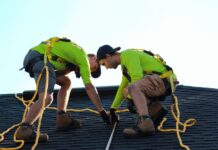As a homeowner, your roof is a crucial component of your house. It protects you and your family from the elements and prevents water damage. However, like everything else in your home, roofs don’t last forever. Catching and addressing issues of a failing roof early can save money and avoid extensive repairs.
In this article, you’ll discover the common signs of a failing roof and what you can do about them:
1. Watch Out for Visible Damage
Regularly inspect your roof, especially after severe weather, to identify any potential issues before seeking service providers like Prairie Roofing. It includes checking shingles and other roofing materials like tiles or metal sheets, as each type has unique signs of wear and failure.
For shingles, look for missing, cracked, or curled pieces. In the case of tiles, check for cracks or breaks. For metal roofing, look for signs of rust, dents, or seams that may be coming apart. These are all clear indicators of an aging roof that may need attention.
Also, be vigilant for bald spots where granules are missing, or if there’s an excessive amount of shingle granules in your gutters. These granules protect the asphalt layer of your shingles from UV rays and rain. When they start to wear off, your roof’s lifespan shortens.
2. Be Alert to Water Damage
You might not notice water damage at first, but it’s something you should keep an eye out for. Inside your home, be vigilant for water stains on the ceiling, walls, or in the attic, as these are common indicators of a leak.
In addition to this, look for any signs of bulging or swelling in your walls or ceilings, as these can also be symptomatic of water damage. Peeling paint from walls or ceilings is another tell-tale sign, often indicating excessive moisture stemming from a leaky roof.
Also, be aware of mold or a musty smell in the attic, as these can indicate moisture issues. Prolonged exposure to water can weaken the structural integrity of your home, so it’s crucial to address these signs promptly.
3. Inspect Your Flashing
Flashing is the material—typically metal—used to seal the roof around chimneys, vents, and where the roof meets a wall. If this is damaged, it can allow water into your home.
Look for rust, cracks, or breaks in the flashing. It’s often a simple fix but crucial for preventing water damage.
Don’t overlook the sealant or caulking around the flashing either, as it can degrade over time, leading to leaks. Regular checks can prevent small issues from turning into a costly repair or replacement.
4. Sagging Spells Trouble
A sagging roof is a serious warning sign and often points to a structural issue. It can be due to various reasons, including long-term water damage, an overloaded roof, design flaws, or inadequate construction.
Immediate professional evaluation is essential. Sagging might indicate weakened roof decking, problematic supports, or flaws in the roof’s design and construction. It’s not merely an aesthetic concern; it can lead to significant structural damage to your home if not promptly addressed.
In addition to potential water damage or excess weight, poor design or construction mistakes can compromise the roof’s integrity, posing safety risks to the occupants. Therefore, identifying the underlying cause is crucial for proper remediation.
5. Check for Daylight Through the Roof Boards
If you see light coming through the roof in your attic, it’s a clear sign that your roof is compromised. This is possibly due to cracks or holes, which are direct pathways for water and pests.
Along with light, check if there’s any moisture in the insulation. Wet insulation is ineffective and can lead to further damage, including mold growth and structural weakening. Both light and moisture are indicators that the roof’s integrity is failing, and immediate action is needed to prevent more extensive issues.

6. Don’t Ignore the Gutters
Your gutters are crucial in maintaining the health of your roof and protecting your home’s foundation. Here’s what to keep in mind when trying to remedy a failing roof:
- Gutters Should Be Free from Debris: To maintain an efficient water drainage system, it’s essential to regularly clear your gutters of accumulated leaves, twigs, and miscellaneous debris, as these can obstruct the smooth flow of water. This can lead to water spilling over the sides, damaging your roof and siding, and potentially leading to foundation issues.
- Check for Proper Water Flow and Downspout Direction: During rain, observe if water flows smoothly through your gutters and downspouts. Ensure that downspouts are directing water away from the foundation of your house to prevent basement flooding and foundation damage. Any overflow or leakage indicates a blockage or damage that needs immediate attention.
- Look for Signs of Wear: Gutters can suffer from wear and tear over time. Rust, holes, or sagging sections can compromise their effectiveness and may require repair or replacement.
By keeping your gutters clean, ensuring proper water flow, and checking the direction of downspouts, you’re taking crucial steps in protecting both the roof and the foundation of your home. Regular gutter maintenance prevents potential water damage and extends the life of your roofing system.
7. Age Matters
The durability of a roof is influenced by a multitude of factors, leading to significant variations in its longevity. A typical roof may endure for approximately 20 to 25 years. However, this estimate is subject to change depending on the specific roofing materials utilized, the prevailing weather conditions in the area, and the degree of maintenance the roof receives.
For instance, certain materials like metal or tile may have longer lifespans, while those in areas with harsh weather conditions may deteriorate faster. It’s important to adjust expectations and inspection frequency based on these factors.
8. Professional Inspections Are Key
Routine professional inspections are crucial for maintaining a healthy roof. Here are a few points to consider:
- Expert Eyes Catch Hidden Flaws: An experienced expert can spot problems that may go unnoticed by those without specialized training, like subtle leaks or signs of deterioration.
- Preventive Maintenance Saves Money: Regular inspections allow for early detection of issues, preventing them from escalating into costly repairs. A professional can provide a maintenance plan tailored to your roof’s age and condition.
- Safety First: Inspecting a roof can be risky. Professionals have the right tools and safety equipment to do this safely, reducing the risk of accidents.
Investing in professional inspections ensures your roof’s longevity and protects your home against future damages.
Conclusion
If you’ve identified any of these issues of a failing roof, don’t delay. Minor problems can quickly turn into major ones. For small fixes, you might be able to do it yourself. But it’s best to call in a professional for more significant issues. Performing consistent maintenance on your roof can prolong its durability and ultimately result in cost savings over time.
Find a Home-Based Business to Start-Up >>> Hundreds of Business Listings.
















































